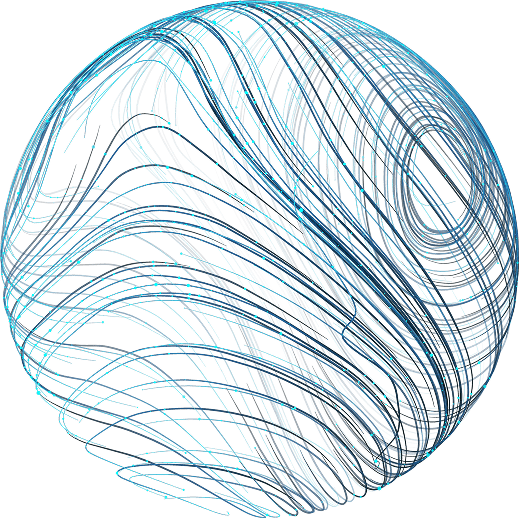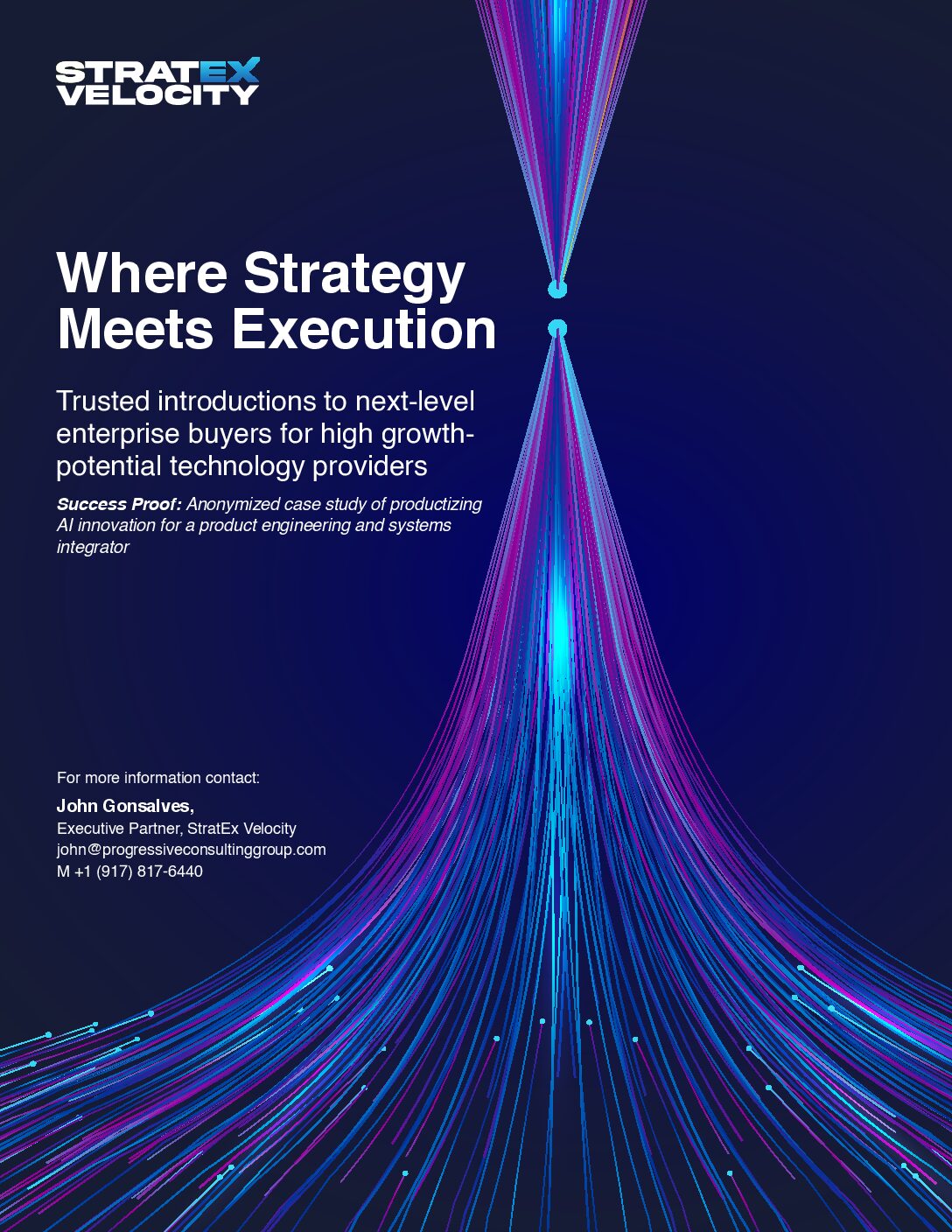Overview
BuDaaS constitutes an autonomous business-growth activity performed by StratEx executives that add little or no additional burden to Clients.
This business development activity can play a pivotal role in new market creation for never-been-done-before innovations—transformative products and services.
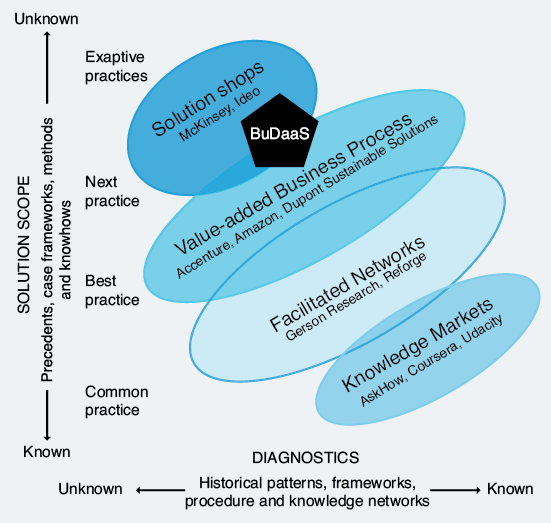
Strategy Execution
Beyond trusted introductions and ongoing advice to both Enterprise customers and their chosen technology providers, the partners of StratEx provide insights, tools and programs for profitable growth.
We Specialize in One Game-Changing Capability
Forging innovation partnerships between Start-ups and Large Enterprises
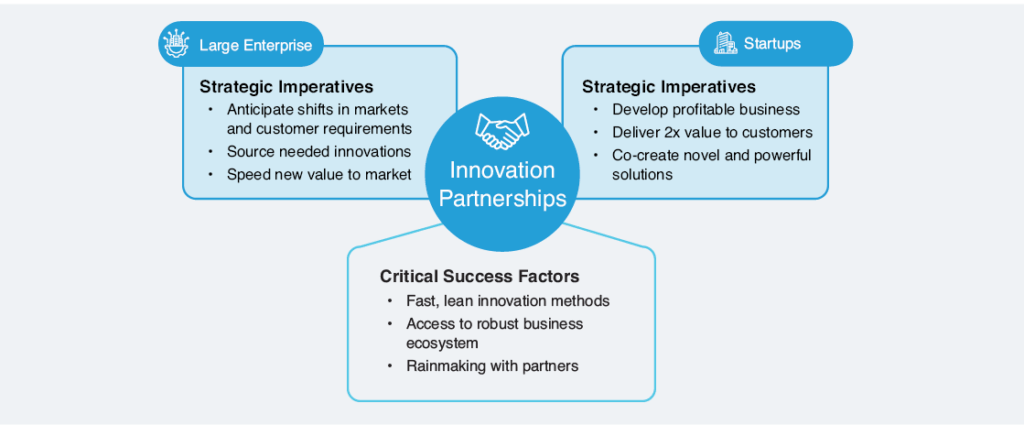
Featured StratEx Client Engagement
Transformative Impact of Landing Three Next-level Enterprise Customers

A product engineering and systems integrator sought enhanced win rates, faster sales cycles, growth, and better margins.
StratEx assisted its client in securing next-level Enterprise and SaaS customers, increasing the gross revenue and profitability per engagement.
Our engagement focused on transforming the client’s position in the cloud, mobile, and AI technology value chain, converting upstream innovations into enterprise and SaaS solutions.
Revenue optimization that leveraged three key levers:
- Strategic introductions,
- Innovation partnerships, and
- Concierge prototypes of new service offerings.
Comprehensive change management approach that drove successful transformation through:
- Executive coaching that aligned board and C-suite stakeholders around new strategic initiatives,
- Team science methodologies that broke down silos and fostered cross-functional collaboration, and
- Cultural transformation programs that embedded innovation-first thinking across the organization.
Engagement Results
Key Results Validated Strategic Partnership Model
StratEx introduced three prototyping customers that yielded substantial revenue and operational insights within six months.
High-level customer and partner relationships spawned three contracts worth $100,000 to $500,000 each.
Success-driven partnerships in both SaaS and Enterprise segments established sustainable revenue streams through co-selling arrangements—and a sales pipeline of $10M.
Sales motions uncovered key operational gaps in personnel, processes, and platforms, setting up an ongoing StratEx engagement.
Motivated Customers
Why Warm Introductions by Trusted Advisors Deliver 10x More Value
Customer Innovation Emerges Through Effective Partnering
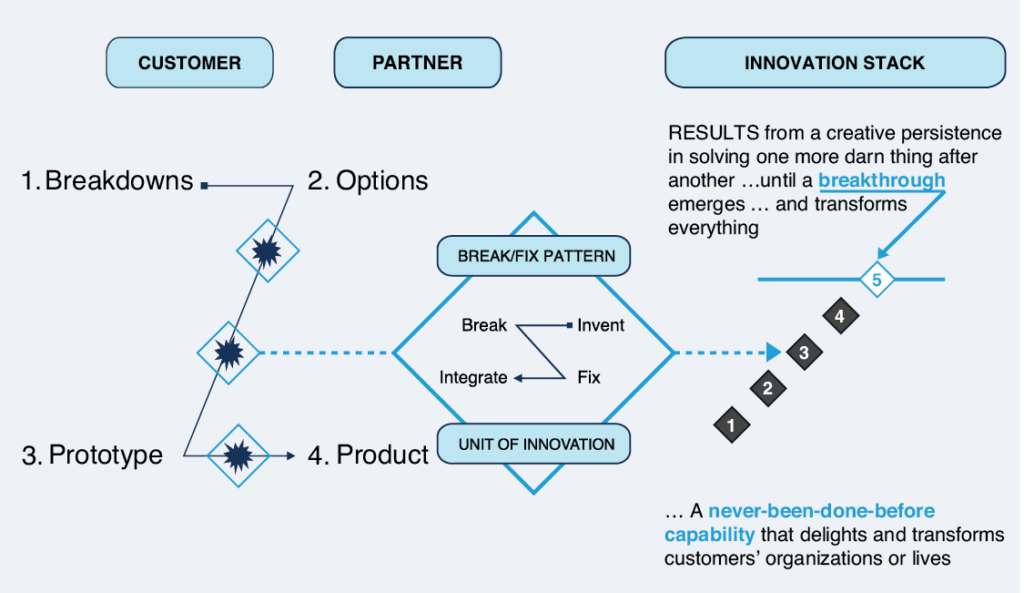
Motivated customers and strategic partnerships power the innovation flywheel (depicted in the figure above), calling attention to three guiding principles.
Good innovation starts with warm introductions by a trusted advisor who will also provide advice to the customer AND providers throughout the project.
Patience that commercial breakthroughs will emerge from at least five and as many as 13 Invent-Break-Fix-Integrate patterns.
A known and proven pattern for innovating transformative products, when understood and accepted, can simplify and embolden sustained action.
Customers can, if not advised otherwise, insist on urgent but blind action. From Special Forces we gain sage advice:
Slow is smooth, and smooth is fast.
Innovation Flywheel for Co-Development
Transformative Collaboration Starts With Customers
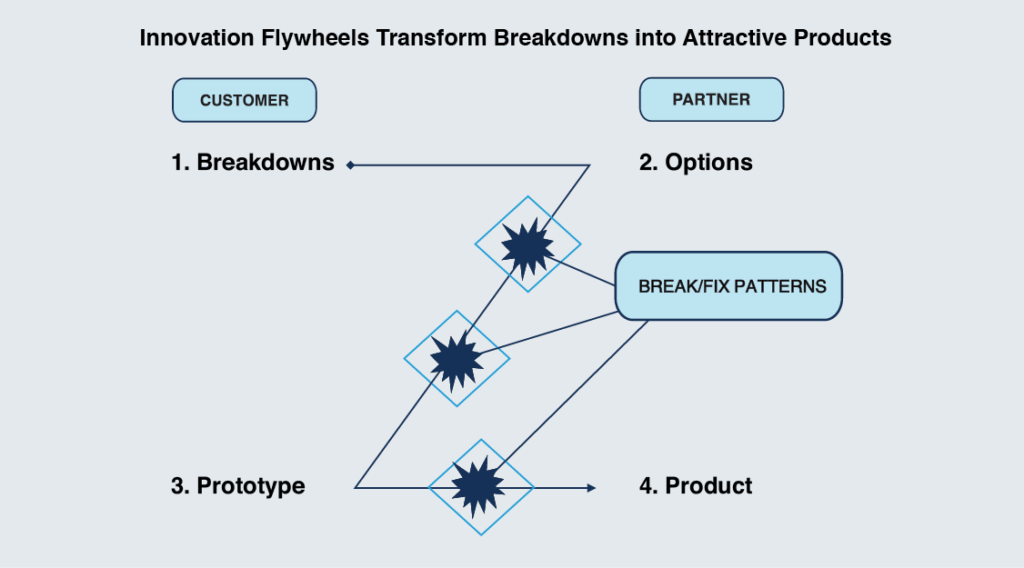
The Innovation Flywheel (depicted above) summarizes a simple, repeatable pattern for co-creating groundbreaking products.
This pattern emphasizes iterative problem-solving, collaboration, and persistent innovation with partners and customers.
Breakdowns: The process begins with identifying customer breakdowns and related jobs to be done. Often this entails examining the capability maturities of core and emergent business processes of selected customers.
Options: The provider begins exploring various options to address unmet needs and challenges. StratEx has found the provider’s leadership cannot envision many of the most attractive or transformative options and become too quick to discount options due to conflicts with their organization’s identity and business model. (for more on this, see Innovation Traps).
Prototypes: In close collaboration with ideal customers of a strategic beachhead, the provider begins workshopping the use case scenarios and requirements (business, product, technical and user experience). StratEx has found that the best ideal customers will co-fund the rapid development of a production pilot—that produces tangible results within weeks or months.
Product: The goal of the solution prototyping process is to produce a promising breakthrough innovation. However, it may take delivering the innovative solution to 10 to 30 customers before understanding the requirements of a whole product.
Most breakthrough innovations emerge from five to 14 break/fix patterns, emphasizing the need for creative persistence and informed patience.
Basic Unit of Innovation: Break/Fix Pattern
Breakthrough Products Emerge From Iteration
Success Comes From 7 to 13
Break/Fix Cycles
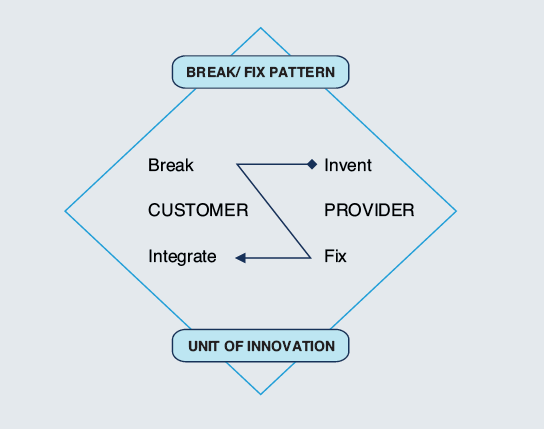
Innovation: It’s a messy, unpredictable process of taking action. Just as a standup comic tries out new comedic bits in night clubs and workshops, innovators test their inventions in realistic but safe sandboxes. StratEx designs and facilitates solutioneering engineering workshops (physical and virtual).
Emergent: Through iterative cycles of inventing, breaking, fixing, and integrating small but meaningful units of progress, a breakthrough product emerges. As introduced by Jack McKelvey,co-founder of Stripe and author the book, The Innovation Stack, breakthrough prototypes require seven to 13 innovations of three types:
- Technology: Software, configurations, infrastructure, etc.
- Business Model: Primary offering, business rules, monetization, etc.
- Engagement policies: Selection of prototyping customers, ways of collaborating, exclusions or not-now actions, etc.
Persistence: For prototypes to evolve into commercial products, a small dedicated team commits to see it through. This emphasizes creative persistence and the patience to work through incremental challenges until they achieve a breakthrough in actual customer experiences.
For these reasons, StratEx recommends starting with a “wow” customer experience, working backwards from that into the business and technical ecosystem for how to deliver that experience.
Fast Invent-Break-Fix-Integrate cycles will produce a breakthrough product, combining technology, business model and engagement policy innovations. However, this requires creative persistence, a proven framework, and faith in the process.
Innovation Stack
Creative Persistences Will Produce Never-been-done-before Innovations
From Idea to Eureka 7 to 15 Break/Fix Cycles
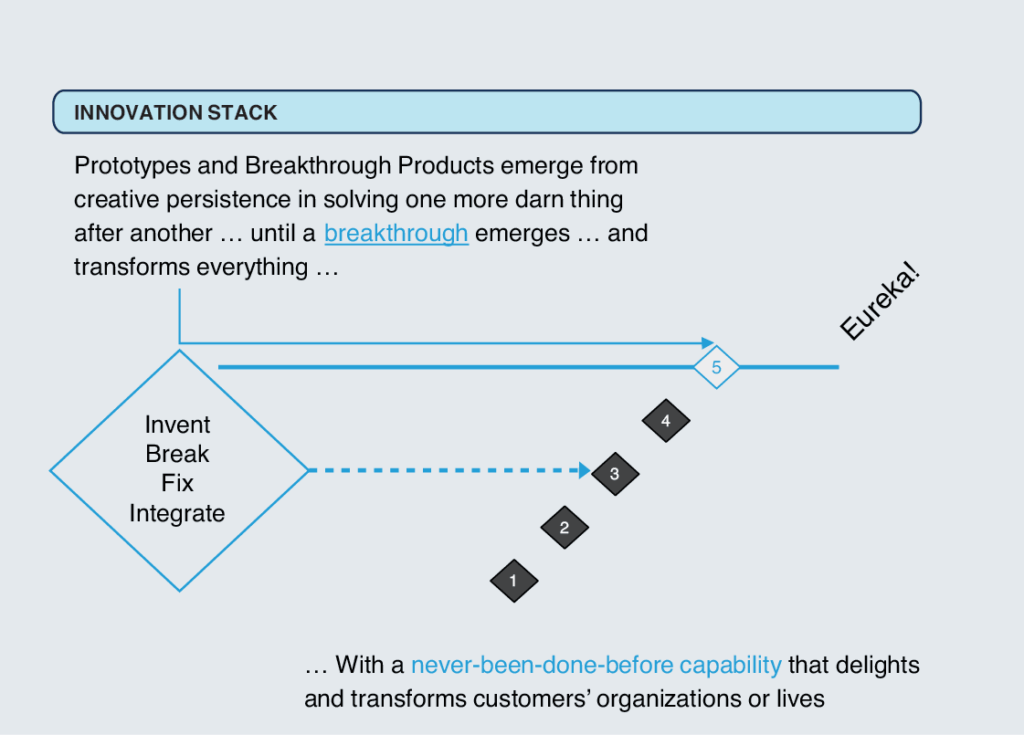
Innovation stacks emerge through creative persistence in solving complex challenges.
Innovation stacks combine technology (33%), business model (33%), and engagement policies (33%) through iterative development small solutions.
Systematic experimentation transforms challenges into repeatable capability patterns.
Breakthrough solutions emerge on predictable but unknown timelines when integrated capabilities reach critical mass.Most attempts by large organizations to innovate more than incremental improvements fail due to the perfect storm of impatience, insufficient curiosity, and weak or informal innovation processes.
Engagement
Three-Horizon Goals Drove Emergence of New Growth Offerings Without Interfering With The Current Business
Goals and Initiatives
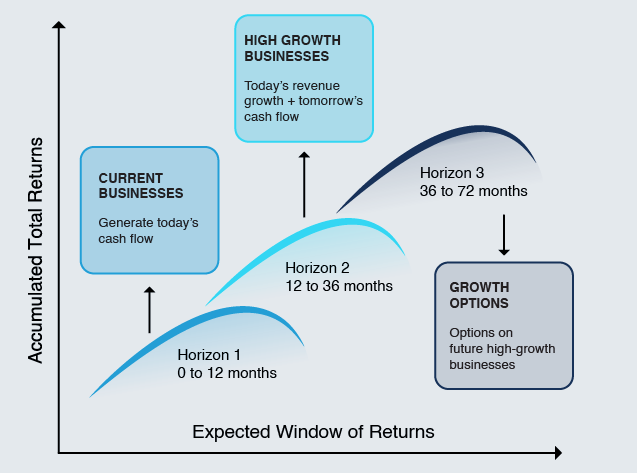
Three time horizons enable the client to balance short term pressure for revenues with longer term strategic objectives.
Time Horizon 1 (0-12 months)
We focused on immediate revenue from proven integration and engineering services, addressing known segments and customer use cases;
Identifying the buyer readiness, their success criteria, and decision processes of their most attractive, profitable and loyal customers;
Optimizing their proposal process for 11 to 15 unseen stakeholders with the Enterprise and partners, including the executive committee, board of directors and trusted advisors; and Engineering their website for continuous conversion rate optimization.
Time Horizon 2 (12-36 months)
We set the goal of
Developing of one product with paid engagements;
Producing $750,000 ACV from three beachhead customers; and
Forging five technology and service provider partnerships.
Execution provided 18 high-level executive introductions to attractive Enterprise and SaaS buyers, resulting in three commercial engagements.
Time Horizon 3 (36-72 months)
We recommended merging mainstream commercial activities with scalable beachhead successes, creating integrated growth options for future high-growth products.
In support of this Third Horizon, we assembled and managed an Advisory Board of technology, business, and growth funding advisors to guide the client toward its third horizon.
Success required a disciplined focus on market-ready prospects while maintaining parallel tracks for immediate optimization and future innovation.
Success required a disciplined focus on market-ready prospects while maintaining parallel tracks for immediate optimization and future innovation.
Market Transition
Exploiting a Shift in Demand Lead to Breakout Success
Timing shifts in customer requirement often determines big winners from also-rans
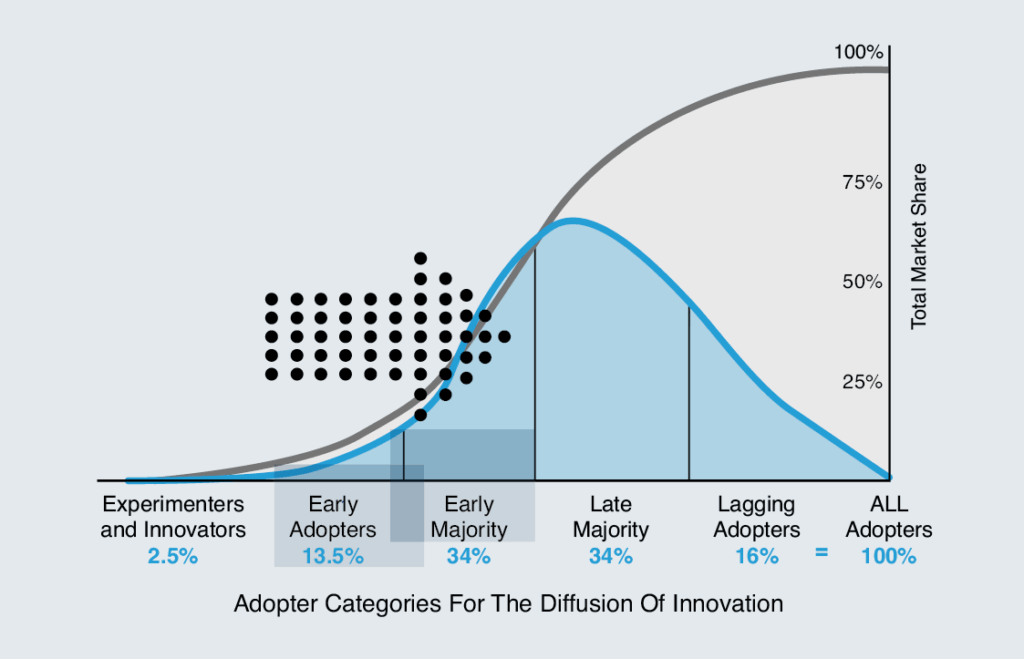
Early Majority Customers
The shift from early adopters to early majority customers demanded a new go-to-market approach.
The market for cloud integration and AI product engineering had evolved beyond early adopter focus on bleeding-edge technology towards more pragmatic business-case-driven solutions.
While competitors remained fixated on experimenters and early adopters (16%), market data showed major opportunity in the early majority segment (34%) seeking proven solutions.
Strategic differentiation emerged from addressing the practical needs of the early majority of customers while competitors pushed a bleeding-edge technology positioning.
We advised positioning of our clients product engineering for early majority customers—buyers who insist on a more package, lower-risk service.
This meant delivering a solution engineering service as a product with a fixed priced, delivery timeline and a well reasoned business case with a concrete return on investment.
Breakthrough Prototypes
Saying No Is A True Superpower of Innovators
The development of breakthrough prototypes marks the creation of transformative products, following a well-established and proven pattern rooted in Silicon Valley and other global hubs of innovation excellence:
Target Strategic Use Cases and Users
- Design breakthrough prototypes for high-impact applications with select early adopters
- Extract critical insights into unmet needs and value creation opportunities
- Minimize risk through focused engagement before scaling
Validate Core Value
- Investigate and document jobs-to-be-done across functional, emotional, interpersonal, and institutional domains
- Align innovation with real-world decision contexts
- Build a foundation for market adoption
Co-Engineer Solutions
- Evolve prototypes through stakeholder collaboration and service design
- Build change management into the offering, often as a managed service
- Align with operational realities and user needs
Prove Value in a Safe Sandbox
- Deploy virtualized capabilities rapidly in a controlled environment
- Demonstrate value using customer data with risk controls
- Structure proof-of-value contracts with clear business outcomes
ADOPTER CATEGORIES FOR THE DIFFUSION OF INNOVATION
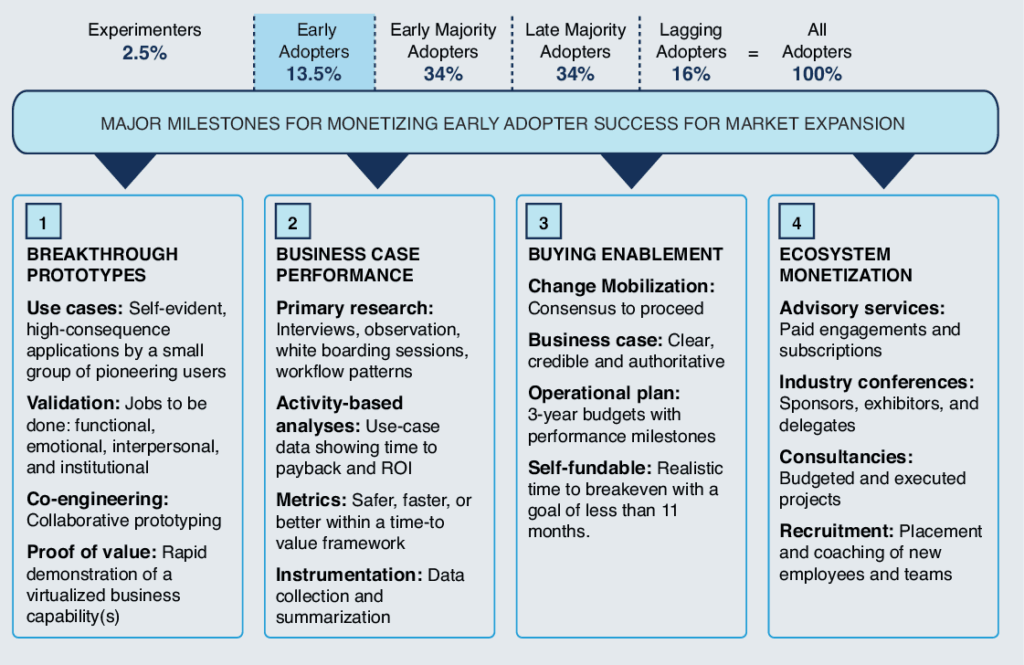
Inflection Point Chaos of AI
Navigating Market Disruptions
Inflection points mark the transition from one paradigm to the next with no coherent view of the future

Market disruption signals opportunity for those who can recognize the convergence of persistent needs of customers and the dynamics of innovation frontiers.
Enterprise and SaaS customers face dual imperatives: maintain competitive advantage while leveraging cloud, mobile, and AI technologies to create new value.
Widespread AI adoption created market uncertainty, demanding rapid experimentation to uncover hidden requirements for breakthrough innovations.
Most traditional go-to-market motions fail to deliver an expected return on investment, calling attention to the role of StratEx and its offering of business development as a service.
In times of rapid change and uncertainty, warm introductions by trusted advisors prevail where traditional GTM motions with fear of missing out (FOMO) messaging fails.
Go-To-Market Planning and Rapid Execution
Blueprint for Action
Guiding Transformative Product Development
Our simple and proven four-phase method speeds the commercialization of new technologies
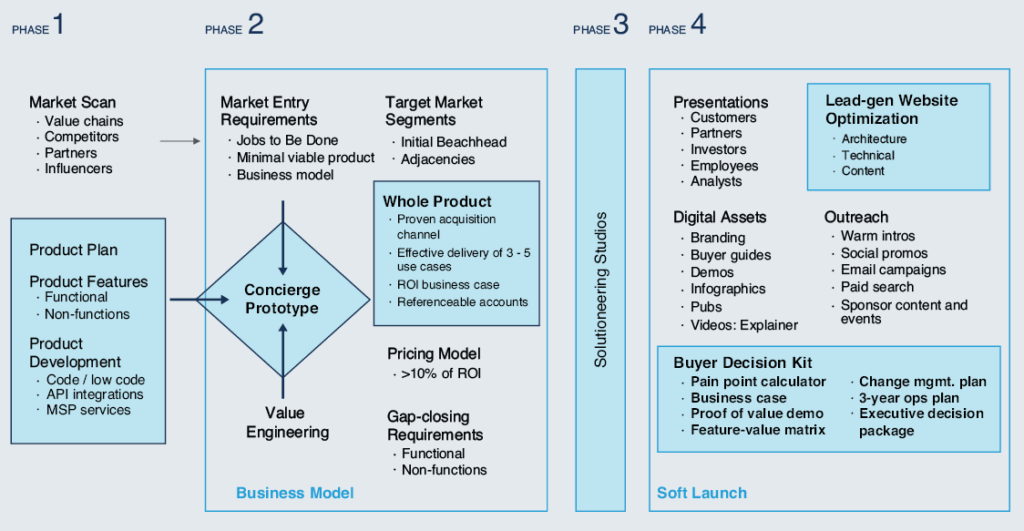
Concierge Prototypes
The StraEx Action Blueprint focused on developing concierge prototypes with three Beachhead customers, validating both market fit and an execution model.
Deep analysis of market entry requirements confirmed jobs-to-be-done, minimum viable product definition, and sustainable business model alignment.
Value engineering emphasized the co-development of integrated products and services to accelerate progressive product builds.
Beachhead customer engagement provided rapid validation of market requirements and execution model.
Clarity and action resulted from working backwards from the development of a concierge prototype for three beachhead customers.
These prototypes are loaded with services that the firm will later strip from the product or offer as a premium for customers seeking customized solutions.
Beachheading enables the development of foundational blocks of a whole product for early majority customers of a larger market.
Solutioneering Studios
Nothing Speed Innovation Than Paired Hands-on-keyboard
Rapid Development of Anything as a Service (XaaS) Simulates Real-world Situations in Confidential Environments
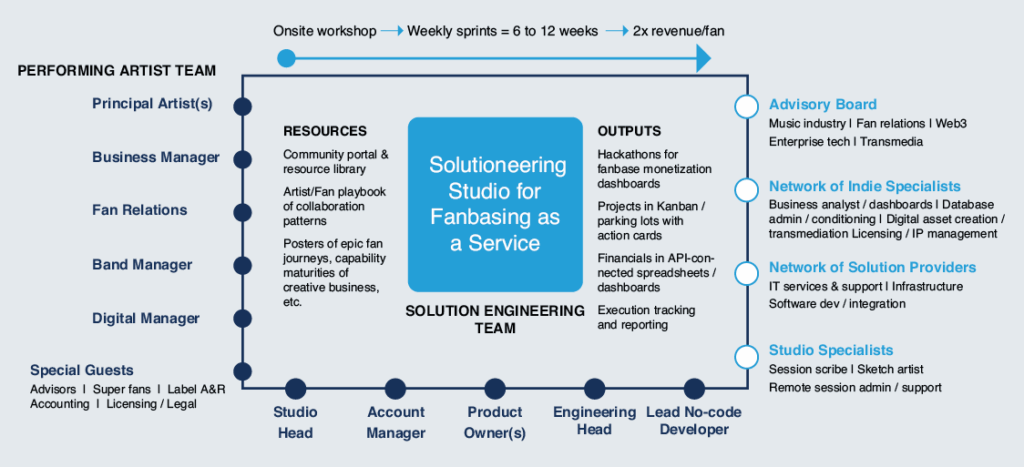
Concierge prototypes speed market validation through hands-on development with select customers with similar business requirements and product use-cases.
The engagement plan centered on co-developing breakthrough products through paid Concierge Prototypes with select customers.
We worked backward from whole product creation with three beachhead customers, integrating market intelligence, entry requirements, and value engineering into production prototypes.
Concierge prototyping strategy enabled beachhead customers to accelerate development of a transformative product while protecting intellectual property rights of the provider, distinguishing them from traditional consulting.
Cross-functional collaboration created integrated solutions, combining product development with business model innovation and go-to-market strategy.
For a client developing a business platform for the performing arts market—musical, theatrical and comedy acts and troupes— we sped development with the active participation of affected stakeholders.
We adapted this framework for our Product Engineering client to produce a concierge prototype for three beachhead customers.
We accomplished this in less than five months—about 65% faster than industry norms.
Revelations from GTM Motions
When Strategy Met Reality
Strategic Mirrors, Market Truths
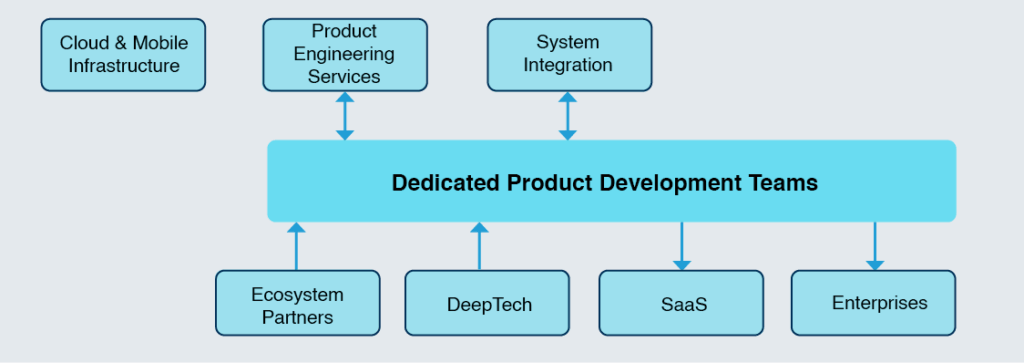
The initial go-to-market motion exposed misaligned sales approaches and the need for market-driven (not just customer-driven) product development.
Hands-on prototyping with future-state users validated the whole-product framework as a critical success driver.
Direct engagement revealed an unspoken demand for transformative solutions beyond feature enhancements, driving the shift from technical capabilities to business critical innovation.
Analysis of individual customer needs revealed broader market patterns, leading to the integration of partner capabilities and ecosystem insights.
Team Microculture Sustained Engagement
Culture Creates Capital
Team microculture evolved into a strategic differentiator, creating premium value through deep client engagement.
Our client’s teams generated compounding value through deep customer engagement, UX insights, and product development.
Team culture emerged as a core driver for retention and future projects.
The provider’s value proposition expanded to feature distinctive packaging of team capabilities and its microculture as differentiated value to customers: Faster time to market, lower technical debt, etc.
Reality Check
Beyond Technical Barriers
Implementation exposed capability gaps spanning technical, cultural, and organizational dimensions, requiring sustained leadership commitment to bridge critical deficits.
Technical requirements expanded beyond initial scope as data engineering and ML Ops capabilities emerged as key differentiators in customer demand and selection of development partners.
Initial engagement teams faced dual integration challenges: securing internal organizational support while building cross-functional alignment within customer organizations.
Leadership commitment proved decisive in sustaining dual-track innovation, balancing immediate revenue targets with strategic product development and capability expansion.
The application of team science to software and AI-fueled innovation will outperform informal teams by as much as 10x.
Lessons Learned
Team Science in Action
Customer-Centric Strategy
Breakthrough success requires three key leadership commitments:
- Prioritize deep customer understanding over prescriptive solutions, shifting teams from traditional sales motions toward market-driven product development.
- Balance customer needs with evolving team capabilities through focused but incremental capability development.
- Guide teams with a singular focus: “What would it take to deliver customer success?”
Innovation Zones
Innovation success demands three critical leadership actions:
- Create protected spaces for next horizon development, insulated from daily operational pressures.
- Shield innovation teams to focus exclusively on emerging market opportunities without legacy constraints.
- Accelerate breakthrough development by maintaining clear separation between innovation and operational demands.
Multi-focus Leadership
Leading dual-track success requires three balanced priorities:
- Drive near-term revenue while building future capability on an incremental basis, maintaining focus on both immediate results and long-term innovation.
- Use partner resources and customer relationships to offset innovation costs, protecting current cash flow demands from investment demands of long-term growth trajectory.
- Align stakeholders across time horizons, balancing immediate business demands with strategic innovation objectives.
Team Culture
Team excellence requires three foundational elements:
- Build and retain dedicated teams as a core strategic asset, protecting key talent for sustained customer engagement.
- Foster distinctive team microcultures that drive unique value creation, premium positioning, and customer loyalty.
- Package high-performing teams with clear brand identity with professional development paths to retain and reward crucial talent and build overall competitive advantage.
Change Assurance
Change leadership demands three sustained commitments:
- Navigate integration barriers and resistance through persistent stakeholder engagement and clear communication.
- Maintain customer engagement through compelling narratives, shared rituals, and direct leadership involvement, weaving transformation goals into team culture and daily practice.
- Drive a clear, consistent, and credible executive personal brand to cut through the complex challenges of technical, cultural, and organizational resistance.
Operational Excellence
Success demands three leadership priorities
- Establish clear team and individual protocols for meetings, decisions, and communications that drive accountability and results.
- Foster excellence through leadership mindset development, individual contribution recognition, and continuous personal growth.
- Build repeatable performance frameworks that scale high-performance culture across teams and engagements.
Business Capability Maturity
Leadership emphasized the cultivation of needed operational capabilities through:
- Accelerate AI capability development focused on ML Ops, empathy engineering, and cyber readiness.
- Design modular frameworks integrating talent, process, and digital assets for rapid deployment.
- Scale through standardized templates that enable swift capability operationalization, combining rapid deployment patterns with service design frameworks for cross-unit adoption.
The rapid execution of strategy and the development of breakthrough products requires more than brute force and iron will.
Success comes from a structured, modular framework, high performing teamwork, and a clear and compelling “just cause”—an inspiring vision for solving hard problems and delighting customers.
About StratEx
Strategy Execution (StratEx) Velocity is a boutique strategy and operations management consulting firm with three Principals: John Gonsalves, Michael Jay Moon, and Nancy Gonsalves.
We bridge the chasm between profitable growth and greater valuations of technology providers.
We add velocity to the execution of strategy, addressing four interrelated growth drivers:
- Customer/Revenue Lifecycle Optimization
- Innovation Partnerships
- Operational Agility
- Team Science
Where Strategy Meets Execution and Produces Outsized Results and Higher Valuation
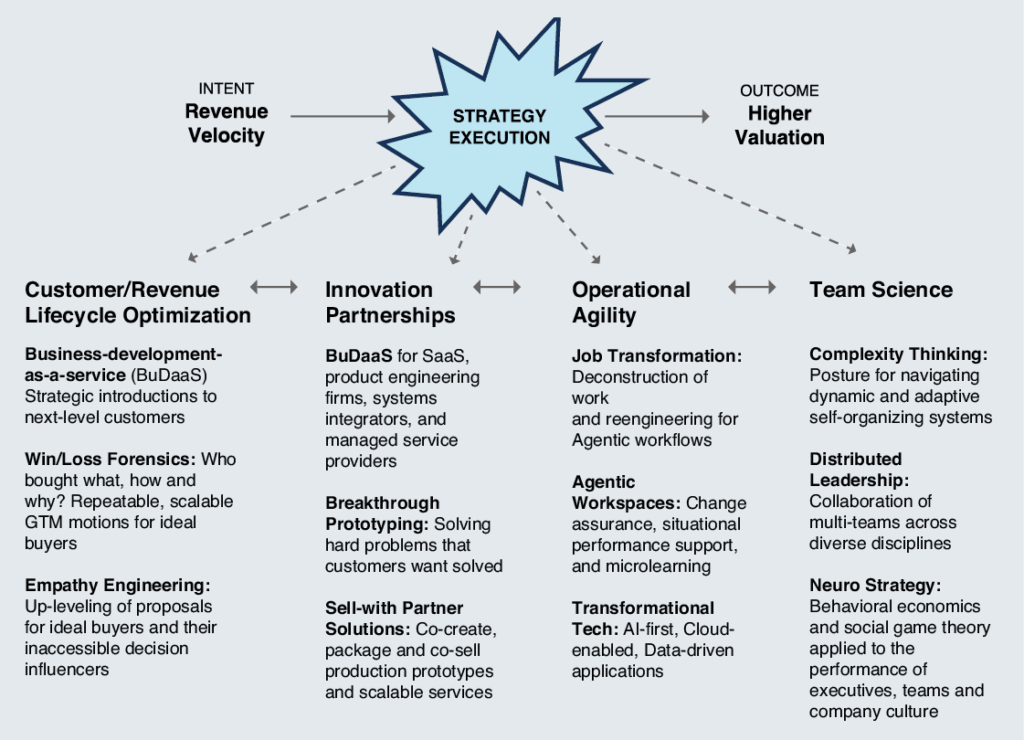
Principals
The team has completed 100-plus client engagements.
This track record of success and earned trust enables direct introductions of SaaS, engineering, and systems integration firms to Enterprises.
John Gonsalves, Executive Partner LinkedIn Twitter John Gonsalves drives digital transformation, growth, and profitability leveraging digital technologies, strategic partnerships, and M&A strategy and post-merger integration.
As a senior executive at Cognizant Digital Business, Symphony Teleca (Samsung-Harman), Aricent (Cap Gemini), EMC Consulting, and ADVENTIS Strategy, he’s generated over $5B in economic value through revenue acceleration, sales optimization and tech ecosystem development.
In global roles, John has advised numerous Global 2000 Enterprises leveraging deep consulting, industry knowledge, and technology integration expertise. Key clients include AT&T, Dell Tech, Ericsson, Facebook, GE Digital, General Dynamics, Google, JP Morgan Chase, Pfizer, SAP, Verizon, and the World Bank.
He holds graduate degrees from IIT Madras (Industrial Management), NYU Stern Business School (Finance & International Business), and MIT Sloan (Executive Management).
Michael Jay Moon, Executive Producer and Multi- contributor, LinkedIn Twitter GISTICS Wikipedia MichaelJayMoon.com
Michael Moon transforms innovative technologies into market-ready solutions for SaaS and MSP startups.
As a Silicon Valley strategist and innovation catalyst, he has guided 45+ startups across B2B, B2B2C, and B2G sectors, generating $8B+ in economic impact and $2.5 B+ in technology revenues.
Specializing in the critical “zero to one” phase, Moon helps founders navigate uncharted market segments through rapid prototyping and market validation.
His innovation think-tank serves as an incubator for breakthrough ideas, while his role as Executive Producer of transmedia publications helps companies craft compelling market narratives.
His insights on brand development, captured in “Firebrands: Building Brand Loyalty in the Internet Age” (13 languages), continue to influence modern marketing strategies.
Nancy E. Gonsalves, General Manager LinkedIn
Ms. Estuart-Gonsalves is a customer-focused, people- oriented leader who founded Progressive Consulting Group, Inc., a leading consulting and systems integration firm,
Her career includes decades of experience in hi-tech manufacturing & logistics in Asia, to digital service automation for leading-edge North American “top 3” law firms.
She supports causes, such as sustainability and diversity, equity, and inclusion (DEI). She is known most for leading with empathy, coaching young entrepreneurs, and developing leaders.
Ms. Estuart-Gonsalves earned her bachelor’s in management engineering from Ateneo University in the Philippines.
